Wai-Fah Chen.The Civil Engineering Handbook
Подождите немного. Документ загружается.

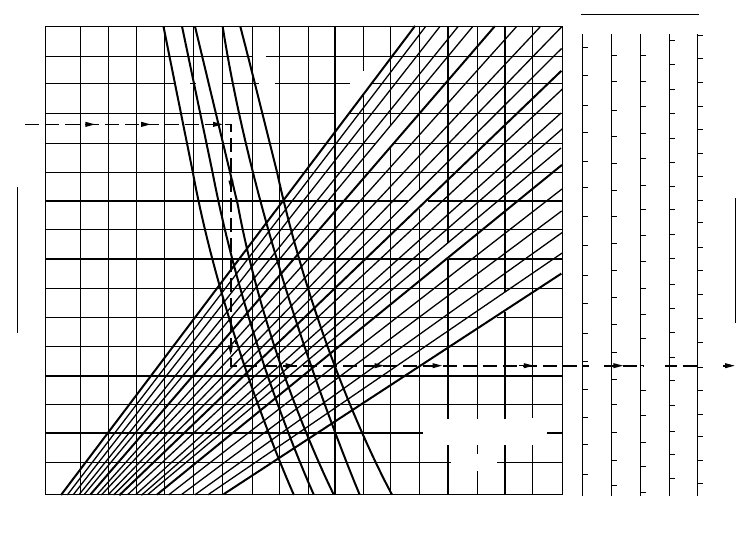
62-60 The Civil Engineering Handbook, Second Edition
Concrete Flexural Strength. The 28-day flexural strength of concrete is determined by ASTM Test
Method C78. A 90-day flexural strength may be used. It can be taken to be 10% higher than the 28-day
strength, except when high early strength cement or pozzolanic admixtures are used.
Foundation Modulus. The subgrade modulus k is determined by the test method specified in AASHTO
T222. When a layer of subbase is used, the design k is obtained from Fig. 62.43 for unstabilized subbase
and Fig. 62.44 for stabilized subbase.
High Traffic Volumes. For airports with design traffic exceeding 25,000 annual departures, the FAA
suggests using thicker pavements as follows: 104, 108, 110, and 112% of design thickness for 25,000 annual
departures for annual departure levels of 50,000, 100,000, 150,000, and 200,000, respectively. This sugges-
tion is based on a logarithmic relationship between percent thickness and departures.
Example 62.21
Determine the thickness of concrete pavement required for the design traffic of Example 62.13. The
subgrade k = 100 pci.
Since the design aircraft exceeds 100,000 lb in gross weight, use 6 in. stabilized subbase. From Fig. 62.44,
effective k = 210 pci. Using concrete with flexural strength of 650 psi, the slab thickness required is 18
in., from Fig. 62.37.
FAA Joint Spacing and Reinforcement Design for Rigid Airport Pavements
The recommended maximum joint spacings are shown in Table 62.22. Tie bars are used across longitudinal
joints. They are deformed bars 5/8 in. (16 mm) in diameter, 30 in. (76 cm) long, and spaced 30 in. (76 cm)
on centers. Dowel bars are used at transverse joints to prevent relative vertical displacement of adjacent
slab ends. Table 62.23 indicates the dowel dimensions and spacings for various slab thicknesses.
The area of steel required for a reinforced concrete pavement is determined by
FIGURE 62.37 Rigid pavement thickness for dual-wheel gear. (Source: Federal Aviation Administration. 1978.
Airport Pavement Design and Evaluation. Advisory Circular AC No. 150/5320-6C. With permission.)
300
DUAL WHEEL GEAR
50,000
0579 E
75,000
100,000
150,000
200,000 Ibs
500
200
100
k = 50 pci
NOTE:
1 inch = 2.54 cm 1 psi = 0.0069 MN/m
2
1 Ib = 0.454 kg 1 pci = 0.272 MN/m
3
22
23
22
21
20
19
18
17
16
15
14
13
10
9
8
7
7
8
9
10
11
13
14
15
16
17
18
19
20
21
22
23
24
26
27
26
25
24
23
22
21
20
19
18
17
16
15
14
12
11
10
9
8
25
24
23
22
21
20
19
18
17
16
15
14
13
12
11
10
9
8
21
20
19
18
17
16
15
14
13
12
11
10
9
8
7
1200 3000 500015,00025,000
ANNUAL DEPARTURES
SLAB THICKNESS ,in
FLEXURAL STRENGTH, psi
900
850
800
750
700
650
600
550
500
13
12
11
12
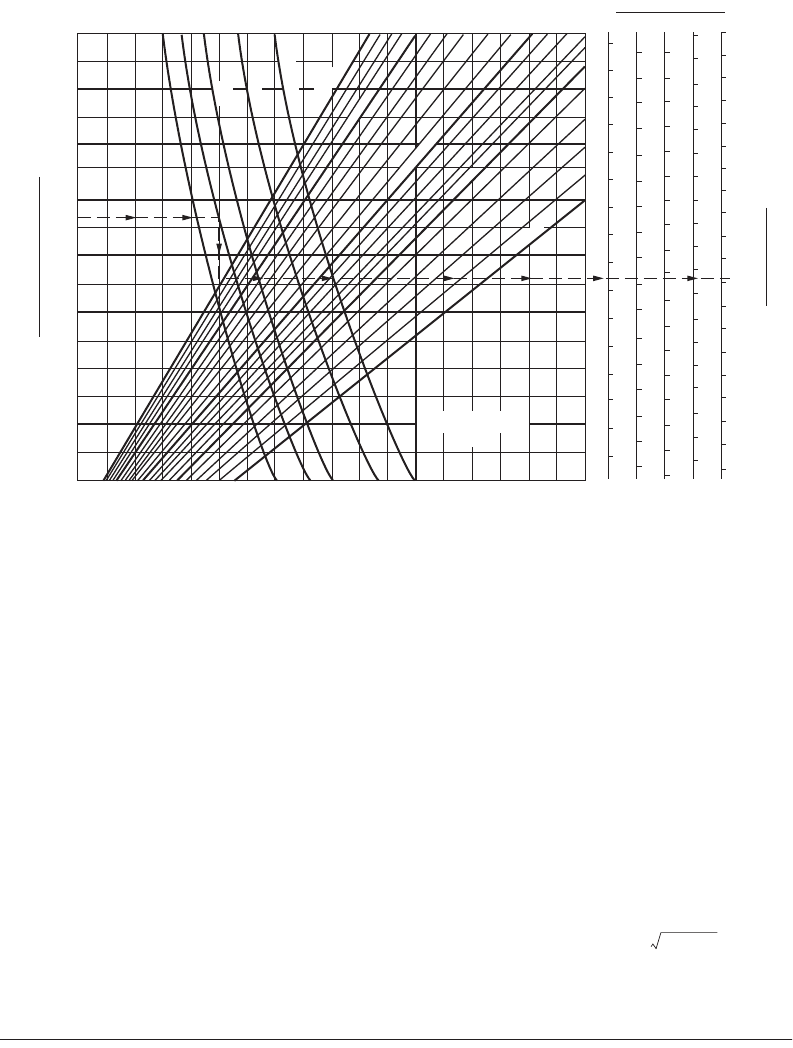
Highway and Airport Pavement Design 62-61
(62.36)
where A
s
=area of steel per foot width or length, in square inches
L =length or width of slab, in feet
t = thickness of slab, in inches
f
s
=allowable tensile stress in steel, in psi, taken as two-thirds of the yield strength of the steel
The minimum percentage of steel reinforcement is 0.05%. The maximum allowable slab length regard-
less of steel percentage is 75 ft (23 m).
Example 62.22
An 18-in.-thick concrete airport pavement has a slab length of 50 ft. Determine the longitudinal steel
requirement.
Using grade 60 steel, f
s
= (60,000) = 40,000 psi. By Eq. (62.36), A
s
= 3.7(50) /40,000 =
0.14 in.
2
per ft. This is equal to 0.016% steel, satisfying the minimum requirement of 0.05%.
62.7 Pavement Overlay Design
As a pavement reaches the end of its service life, a new span of service life can be provided by either a
reconstruction or an application of overlay over the existing pavement. There are three common forms
of overlay construction — bituminous overlay on flexible pavement, bituminous overlay on concrete
pavement, and concrete overlay on concrete pavement. The Asphalt Institute method of flexible overlay
design for highway pavement, the Portland Cement Association method of concrete overlay design for
highway pavement, and the Federal Aviation Administration method of overlay design for airport pave-
ment are described in this section.
FIGURE 62.38 Rigid pavement thickness for dual-tandem gear. (Source: Federal Aviation Administration. 1978.
Airport Pavement Design and Evaluation. Advisory Circular AC No. 150/5320-6C. With permission.)
900
850
800
750
700
650
600
550
500
500
300
200
100
k=50 pci
100,000
150,000
200,000
300,000
400,000 Ibs
1200 3000 5000 15,000 25,000
ANNUAL DEPARTURES
DUAL TANDEM GEAR
0478 E
NOTE:
1 inch = 2.54 cm 1 psi = 0.0069 MN/m
2
1 Ib = 0.454 kg 1 pci = 0.272 MN/m
3
22
23
24
26
27
26
25
24
23
22
21
20
19
18
17
16
15
14
13
12
11
10
9
8
25
24
23
22
21
20
19
18
17
16
15
14
13
12
11
10
9
8
23
22
21
20
19
18
17
16
15
14
13
12
11
10
9
8
7
22
21
20
19
18
17
16
15
14
13
12
11
10
9
8
7
21
20
19
18
17
16
15
14
13
12
11
10
9
8
7
SLAB THICKNESS, in.
FLEXURAL STRENGTH , psi
A
s
3.7 L()Lt()
0.5
f
s
------------------------------=
2
3
--
50()18()
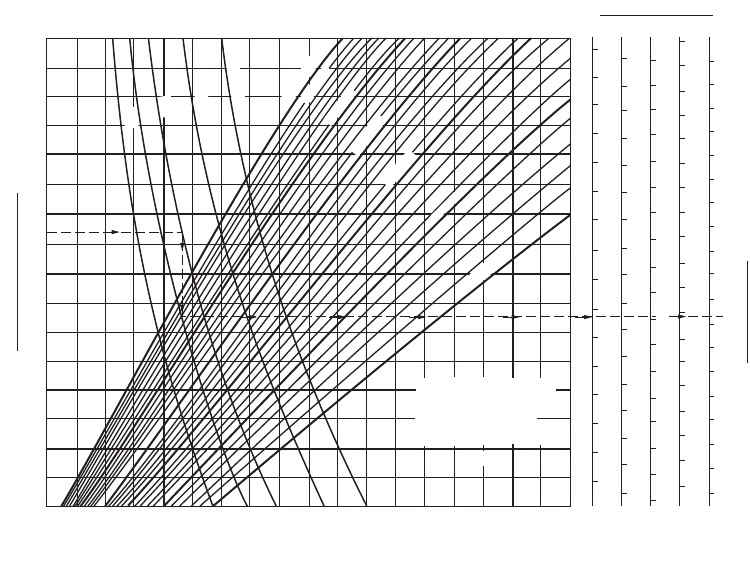
62-62 The Civil Engineering Handbook, Second Edition
AI Design Procedure for Flexible Overlay on Flexible Highway Pavement
The Asphalt Institute [1983] presents two different approaches to flexible overlay design — one based
on the concept of effective thickness and the other based on deflection analysis.
AI Effective Thickness Approach
This approach evaluates the so-called effective thickness T
e
of the existing pavement and determines the
required overlay thickness T
OL
as
(62.37)
where T is the required thickness of a new full-depth pavement if constructed on the existing subgrade,
to be determined from Fig. 62.10.
The Asphalt Institute recommends two methods for evaluating effective pavement thickness. The first
method involves the use of a conversion factor C based on the PSI (present serviceability index) of the
existing pavement plus the use of conversion factors E for converting various pavement layers into
equivalent thickness of asphalt concrete. That is,
(62.38)
where n is the total number of pavement layers. C is obtained from either line A or line B in Fig. 62.45.
Line A assumes that the overlaid pavement would exhibit a reduced rate of change in PSI compared to
before overlay. Line B represents a more conservative design, assuming that the rate of change in PSI
FIGURE 62.39 Rigid pavement thickness for B-747-100, SR, 200B, 200C, and 200F. (Source: Federal Aviation
Administration. 1978. Airport Pavement Design and Evaluation. Advisory Circular AC No. 150/5320-6C. With per-
mission.)
900
850
800
750
700
650
600
550
500
1200 3000600015,000 25,000
ANNUAL DEPARTURES
0378 E
NOTE:
1 inch = 2.54 cm 1 psi = 0.0069 MN/m
2
1 Ib = 0.454 kg 1 pci = 0.272 MN/m
3
22
23
24
26
26
25
24
23
22
21
20
19
18
17
16
15
14
13
12
11
10
9
8
25
24
23
22
21
20
19
18
17
16
15
14
13
12
11
10
9
8
23
22
21
20
19
18
17
16
15
14
13
12
11
10
9
8
7
22
21
20
19
18
17
16
15
14
13
12
11
10
9
8
7
21
20
19
18
17
16
15
14
13
12
11
10
9
8
7
SLAB THICKNESS, in.
FLEXURAL STRENGTH , psi
B747-100, SR,200 B,C,F
CONTACT AREA = 245 sq. in.
DUAL SPACING = 44 in.
TANDEM SPACING = 53 in.
300,000
400,000
500,000
600,000
700,000
800,000
850,000 Ibs
k=50 pci
100
200
300
500
T
OL
TT
e
–=
T
e
Ch
i
E
i
{}
i 1=
n
Â
=
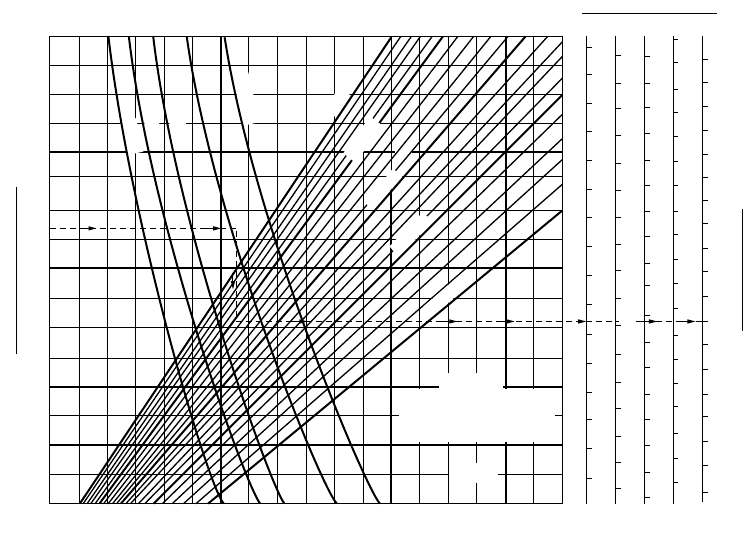
Highway and Airport Pavement Design 62-63
would remain unchanged after overlay. PSI is usually estimated from correlation with pavement roughness
measurements. Equivalency factors E
i
are obtained from Table 62.24.
Example 62.23
An old pavement has 3-in. asphalt surface course and 8.5-in. type II emulsified asphalt base (see
Example 62.12). Its current PSI is 2.8. Provide an overlay to the pavement to carry the design traffic of
Example 62.10.
With PSI = 2.8, C = 0.75 by line A of Fig. 62.45. The thickness of new full-depth asphalt pavement
required is 9.5 in. (see Example 62.12). The equivalency factor of type II emulsified base is 0.83, from
Table 62.24. Overlay thickness T
e
= 9.5 – 0.75{(3 ¥ 1.0) + (8.5 ¥ 0.83)} = 2 in.
The second recommended method relies on component analysis that assigns conversion factors C
i
from Table 62.25 to individual pavement layers based on their respective physical conditions. The effective
thickness for the existing pavement structure is given by
(62.39)
where h
i
= the layer thickness of layer i
n = the total number of layers in the existing pavement
Example 62.24
For the old pavement in Example 62.23, it is observed that the asphalt concrete surface exhibits appreciable
cracking and the emulsified asphalt base has some fine cracking and slight deformation in the wheel
paths. Design an overlay for the same traffic as in Example 62.23.
FIGURE 62.40 Rigid pavement thickness for B-747-SP. (Source: Federal Aviation Administration. 1978. Airport
Pavement Design and Evaluation. Advisory Circular AC No. 150/5320-6C. With permission.)
ANNUAL DEPARTURES
SLAB THICKNESS, in.
FLEXURAL STRENGTH , psi
900
850
800
750
700
650
600
550
500
500
300
200
100
k=50 pci
700,000 lbs
600,000
500,000
400,000
300,000
1200 3000 6000 15,000 25,000
B 747 SP
CONTACT AREA = 210 sq. in.
DUAL SPACING = 43.25 in.
TA ND EM SPACING = 54 in.
0278 E
NOTE:
1 inch = 2.54 cm 1 psi = 0.0069 MN/m
2
1 Ib = 0.454 kg 1 pci = 0.272 MN/m
3
22
23
24
26
26
25
24
23
22
21
20
19
18
17
16
15
14
13
12
11
10
9
8
25
24
23
22
21
20
19
18
17
16
15
14
13
12
11
10
9
8
23
22
21
20
19
18
17
16
15
14
13
12
11
10
9
8
7
22
21
20
19
18
17
16
15
14
12
11
10
9
8
7
21
20
19
18
17
16
15
14
13
12
11
10
9
8
7
13
T
e
h
i
C
i
i 1=
n
Â
=
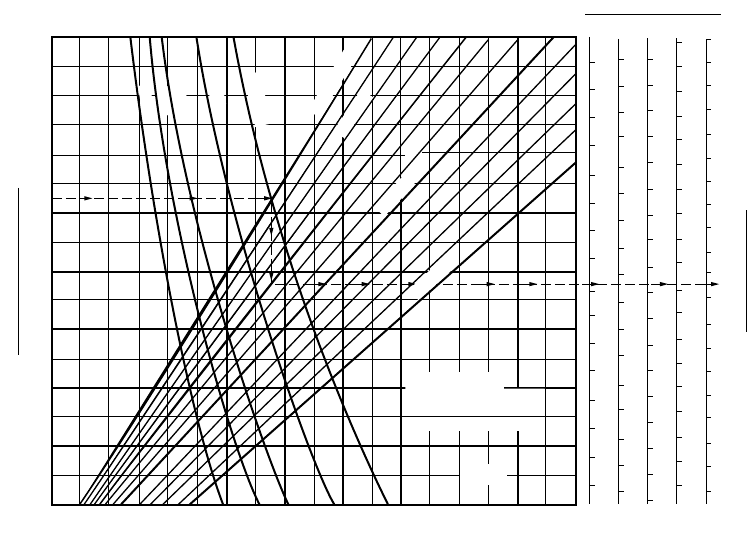
62-64 The Civil Engineering Handbook, Second Edition
From Table 62.25, the conversion factors for the surface and base courses are both 0.6. T
OL
= 9.5 –
{(0.6 ¥ 3) + (0.6 ¥ 8.5)} = 2.6 in. Use 3 in.
AI Deflection-Based Approach
This approach is based on the correlation between wheel load, repetitions of wheel loads, and the
magnitude of pavement rebound deflection. Rebound deflections are measured using the Benkelman
beam on the outer wheel path at a minimum of 10 locations within the test section or a minimum of
20 measurements per mile (12 per km). The Benkelman beam is a 12-ft (3.66-m) beam pivoted at a
point 8 ft (2.44 m) from the probe end. The probe is positioned at the test point between the dual tires
of a rear wheel of a loaded truck that has an 18-kip (80-kN) load equally distributed on its two dual
wheels of the rear axle. The amount of vertical rebound at the test point after the truck moves away is
recorded as the rebound deflection.
The deflection measurements are used to determine a representative rebound deflection d
r
:
(62.40)
where d
m
= the mean of rebound deflection measurements
s = the standard deviation
F = the temperature adjustment factor
c = the critical period adjustment factor
The factor c converts the measured deflection to the maximum deflection that would have occurred
if the test were performed at the most critical time of the year. Numerically, it is equal to the ratio of
measured deflection to the corresponding deflection measurement if it were to be made during the critical
FIGURE 62.41 Rigid pavement thickness for DC 10-10, 10CF. (Source: Federal Aviation Administration. 1978.
Airport Pavement Design and Evaluation. Advisory Circular AC No. 150/5320-6C. With permission.)
ANNUAL DEPARTURES
SLAB THICKNESS ,in
FLEXURAL STRENGTH , psi
900
850
800
750
700
650
600
550
500
500
200
300
k=50 pci
200,000
300,00
400,000
450,000 Ibs.
1200 3000 6000 15,000 25,000
DC 10-10, 10 CF
CONTACT AREA = 294 sq. in.
DUAL SPACING = 54 in.
TANDEM SPACING = 64 in.
0278 E
NOTE:
1 inch = 2.54 cm 1 psi = 0.0069 MN/m
2
1 Ib = 0.454 kg 1 pci = 0.272 MN/m
3
22
23
24
26
26
27
25
24
23
22
21
20
19
18
17
16
15
14
13
12
11
10
9
8
25
24
23
22
21
20
19
18
17
16
15
14
13
12
11
10
9
8
23
22
21
20
19
18
17
16
15
14
13
12
11
10
9
8
7
22
21
20
19
18
17
16
15
14
13
12
11
10
9
8
7
21
20
19
18
17
16
15
14
13
12
11
10
9
8
7
100
d
r
d
m
2s–()Fc=
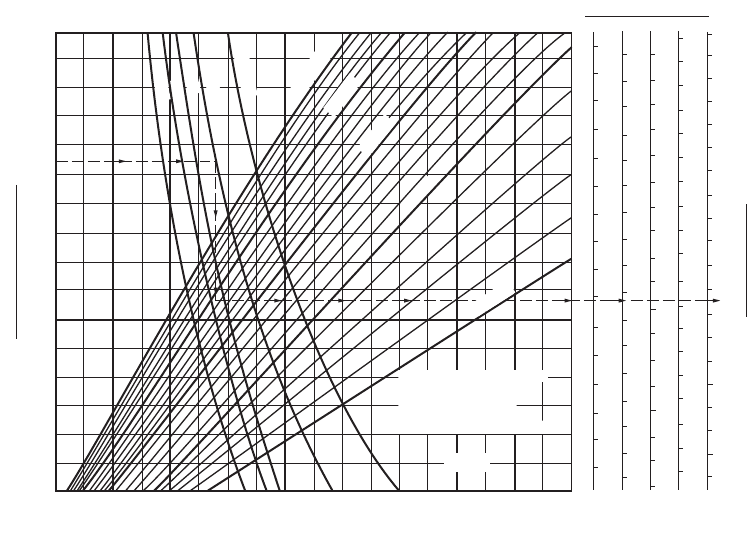
Highway and Airport Pavement Design 62-65
period. It can be established from historical records or derived from engineering judgment when no
record is available.
F is determined from Fig. 62.46 with two inputs: thickness of untreated granular base and mean pavement
temperature. The estimation of mean pavement temperature requires information of the pavement surface
temperature at the time of test and the 5-day mean air temperature computed from the maximum and
minimum air temperature for each of the 5 days prior to the date of deflection testing. Fig. 62.47 is used
to obtain temperature at the middepth and bottom of the pavement. Next, the surface temperature, mid-
depth temperature, and bottom temperature are averaged to provide the mean pavement temperature.
Having computed the representative rebound deflection, Fig. 62.48 is used to determine the required
overlay thickness. The design ESAL is estimated by means of the procedure described under the heading of
traffic-loading computation.
Example 62.25
Rebound deflection measurements made at 12 randomly selected locations on an old asphalt pavement
using Benkelman beam produced the following net rebound deflections in in.: 0.038, 0.035, 0.039, 0.039,
0.039, 0.039, 0.044, 0.044, 0.037, and 0.036. The temperature of pavement surface was found to be 131˚F.
The extreme air temperatures in the previous 5 days were (88˚F, 75˚F), (86˚F, 75˚F), (90˚F, 77˚F), (88˚F,
77˚F), and (88˚F, 75˚F). The thickness of the asphalt layer was 6 in. The thickness of untreated granular
base was 12 in. Determine the overlay thickness required to carry additional ESAL of 5 ¥ 10
6
.
Mean deflection d
m
= 0.0391 in. and standard deviation s = 0.0029. Five-day mean air temperature =
81.9˚F. From Fig. 62.47, pavement layer middepth temperature T
1
= 105˚F and bottom temperature T
2
=
100˚F. Mean pavement temperature = 112˚F. From Fig. 62.46, F = 0.82.
Assuming a critical period factor of c = 0.9, d
r
= {0.0391 + 2(0.0029)} ¥ (0.82)(0.9) = 0.0331 in. For
design ESAL of 5 ¥ 10
6
, read from Fig. 62.48, the overlay thickness is 3 in.
FIGURE 62.42 Rigid pavement thickness for DC 10-30, 30CF, 40, and 40CF. (Source: Federal Aviation Administra-
tion. 1978. Airport Pavement Design and Evaluation. Advisory Circular AC No. 150/5320-6C. With permission.)
FLEXURAL STRENGTH , psi
900
850
800
750
700
650
600
550
500
k=50 pci
200,000
300,000
400,000
500,000
600,000 Ibs
DC-10-30, 30 CF, -40, 40 CF
CONTACT AREA = 331 sq. in.
DUAL SPACING = 54 in.
TANDEM SPACING = 64 in.
CENTER GEAR SPACING = 37.5 in.
0478 E
100
200
300
500
ANNUAL DEPARTURES
1200 3000 600015,00025,000
SLAB THICKNESS, in.
26
27
25
24
23
22
21
20
19
18
17
16
15
14
13
12
11
10
9
8
26
25
24
23
22
21
20
19
18
17
16
15
14
13
12
11
10
9
8
24
23
22
21
20
19
18
17
16
15
14
13
12
11
10
9
8
7
23
22
21
20
19
18
17
16
15
14
13
12
11
10
9
8
7
22
21
20
19
18
17
16
15
14
13
12
11
10
9
8
7
NOTE:
1 inch = 2.54 cm 1 psi = 0.00069 MN/m
2
1 Ib =0.454 kg 1 pci = 0.272 MN/m
3
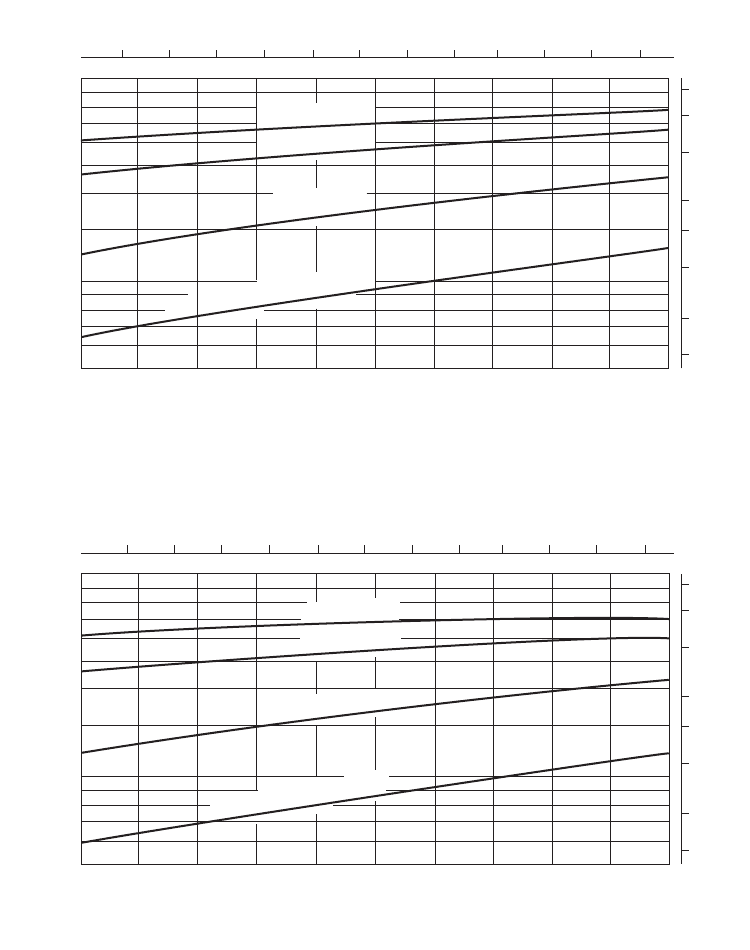
62-66 The Civil Engineering Handbook, Second Edition
AI Design Procedure for Flexible Overlay on Rigid Highway Pavement
Two design procedures are presented by the Asphalt Institute [1983], namely, the effective thickness
procedure and the deflection procedure.
AI Effective Thickness Procedure
The component analysis procedure described earlier for asphalt overlay on flexible pavement also applies
for the design of asphalt overlay on concrete pavement. The same table (Table 62.25) is used for both.
FIGURE 62.43 Effect of subbase on subgrade modulus. (Source: Federal Aviation Administration. 1978. Airport
Pavement Design and Evaluation. Advisory Circular AC No. 150/5320-6C, p. 25. With permission.)
EFFECTIVE K ON TOP OF SUBBASE
( MN/m
3
)
4
50
100
200
300
400
500
5678910
THICKNESS OF SUBBASE, INCHES
BANK - RUN SAND & GRAVEL (P1 < 6)
11 12 13
34323028262422
( cm )
2018161412
14
125
100
( MN / m
3
)
LB / IN
3
75
50
40
30
20
15
4
50
100
200
300
400
500
5678910
THICKNESS OF SUBBASE, INCHES
WELL - GRADED CRUSHED AGGREGATE
11 12 13
343230282624
K = 300 (81)
K = 200 (54)
K = 100 (27)
SUBGRADE K = 50 (14)
K = 300 (81)
K = 200 (54)
K = 100 (27)
SUBGRADE K = 50 (14)
22
( cm )
2018161412
14
125
100
LB / IN
3
75
50
40
30
20
15
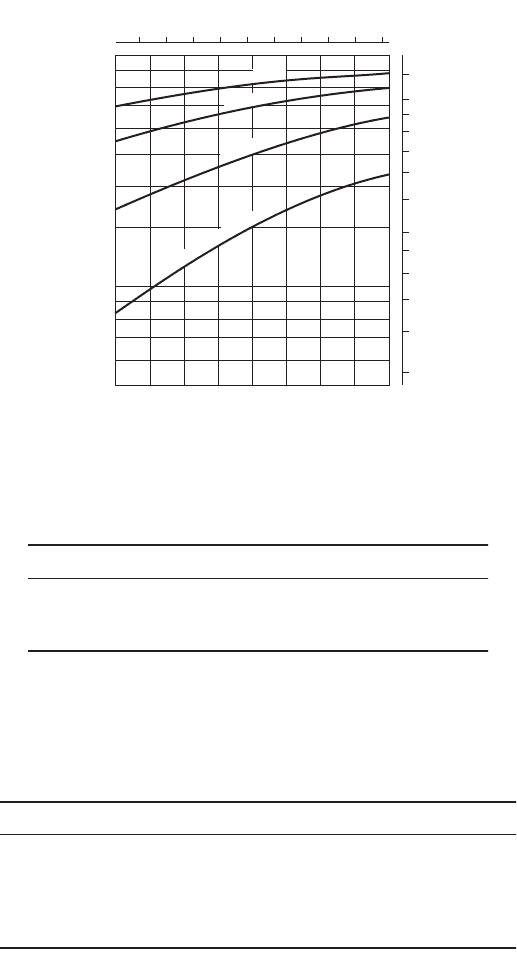
Highway and Airport Pavement Design 62-67
AI Deflection-Based Procedure
Deflection measurements are made using Benkelman beam or other devices at the following locations:
(a) the outside edge on both sides of two-lane highways; (b) the outermost edge of divided highways;
and (c) corners, joints, cracks, and deteriorated pavement areas.
FIGURE 62.44 Effect of stabilized subbase on subgrade modulus. (Source: Federal Aviation Administration. 1978.
Airport Pavement Design and Evaluation. Advisory Circular AC No. 150/5320-6C, p. 64. With permission.)
TA BLE 62.22
FAA Recommended Maximum Joint Spacings
Slab Thickness Transverse Spacing Longitudinal Spacing
<9 in. (23 cm) 15 ft (4.6 m) 12.5 ft (3.8 m)
9–12 in. (23–31 cm) 20 ft (6.1 m) 20 ft (6.1 m)
>12 in. (31 cm) 25 ft (7.6 m) 25 ft (7.6 m)
Source: Federal Aviation Administration. 1978. Airport Pavement
Design and Evaluation. Reprinted from FAA Advisory Circular. Report
FAA/AC-150/5320-6C. 7 December 1978; NTIS Accession No. AD-A075
537/1.
TA BLE 62.23 Dowel Bar Dimensions and Spacings
Slab Thickness Diameter Length Spacing
6–7 in. (15–18 cm) 0.75 in. (20 mm) 18 in. (46 cm) 12 in. (31 cm)
8–12 in. (21–31 cm) 1 in. (25 mm) 19 in. (48 cm) 12 in. (31 cm)
13–16 in. (33–41 cm) 1.25 in. (30 mm)* 20 in. (51 cm) 15 in. (38 cm)
17–20 in. (43–51 cm) 1.50 in. (40 mm)* 20 in. (51 cm) 18 in. (46 cm)
21–24 in. (54–61 cm) 2 in. (50 mm)* 24 in. (61 cm) 18 in. (46 cm)
*Dowels may be a solid bar or high-strength pipe. High-strength pipe dowels
must be plugged on each end with a tight-fitting plastic cap or with bituminous
or mortar mix.
Source: Federal Aviation Administration. 1978. Airport Pavement Design and
Evaluation. Reprinted from FAA Advisory Circular. Report FAA/AC-150/5320-6C.
7 December 1978; NTIS Accession No. AD-A075 537/1.
K ON TOP OF SUBBASE LB/IN
3
500
400
300
200
100
90
80
70
60
50
( MN / m
3
)
50
40
35
30
25
20
45678
THICKNESS OF SUBBASE, INCHES
9101112
15
12 14 16 18 20
( CM )
22 24 26 28 30
120
100
90
80
70
60
K = 300 (81)
K = 200 (54)
K = 100 (27)
SUBGRADE K = 50 (14)
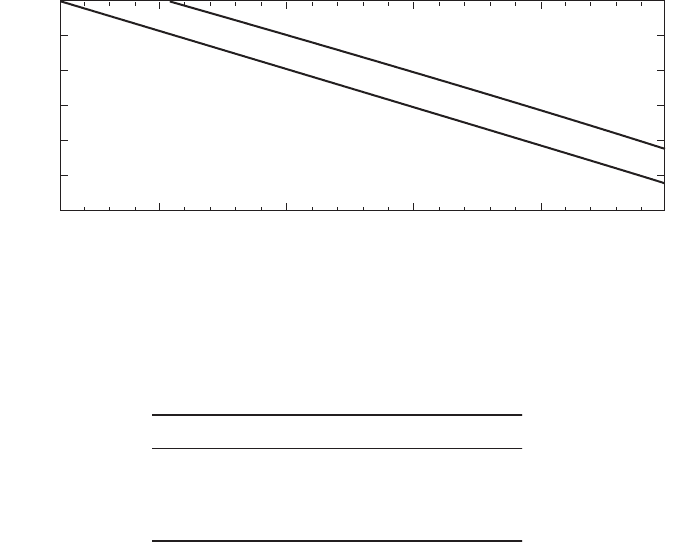
62-68 The Civil Engineering Handbook, Second Edition
For JPCP and JRCP the differential vertical deflection at joints should be less than 0.05 mm (0.002 in.)
and the mean deflection should be less than 0.36 mm (0.014 in.). For CRCP, Dynaflect deflections of
15 to 23 mm (0.0006 to 0.0009 in.) or greater lead to excessive cracking and deterioration. Undersealing
or stabilization is required when the deflection exceeds 15 mm (0.0006 in.).
Dense-graded asphalt concrete overlay can reduce deflections by 0.2% per mm (5% per in.) of
thickness. However, depending on the mix type and environmental conditions, deflection may be as high
as 0.4 to 0.5% per mm (10 to 12% per in.). If a reduction of 50% or more of deflection reduction is
required, it is more economical to apply undersealing before overlay is considered. For a given slab length
and mean annual temperature differential, the required overlay thickness is selected from Fig. 62.49. The
thicknesses are provided to minimize reflective cracking by taking into account the effects of horizontal
tensile strains and vertical shear stresses.
The design chart has three sections — A, B, and C. In section A, a minimum thickness of 100 mm
(4 in.) is recommended. This thickness should reduce the deflection by an estimated 20%. In sections B
and C, the thicknesses may be reduced if the pavement slabs are shortened by breaking and seating
(denoted as alternative 2 in Fig. 62.49) to reduce temperature effects. This is recommended as an overlay
thickness approaches the 200- to 225-mm (8- to 9-in.) range. Another alternative is the use of a crack
relief layer (denoted as alternative 3 in Fig. 62.49). A recommended crack relief structure is a 3.5-in.-
thick layer of coarse, open-graded hot mix containing 25 to 35% interconnecting voids and made up of
100% crushed material. It is overlain by a dense-graded asphalt concrete surface course (at least 1.5 in.
thick) and a dense-graded asphalt concrete leveling course (at least 2 in. thick).
Example 62.26
The vertical deflections measured by a Benkelman beam test at a joint of a portland cement concrete
pavement are 0.042 and 0.031 in. The pavement has a slab length of 40 ft. Design an asphalt concrete
overlay on the concrete pavement. The design temperature differential is 80˚F.
FIGURE 62.45 PSI-based conversion factors for determining effective thickness. (Source: Asphalt Institute. 1983a.
Asphalt Overlays for Highway and Street Rehabilitation. Manual Series MS-17, p. 51. With permission.)
TA BLE 62.24 Asphalt Institute Equivalency
Factors for Converting Layers of Other Material
Types to Equivalent Thickness of Asphalt Concrete
Material Type Equivalency Factor E
i
Asphalt concrete 1.00
Type I emulsified asphalt base 0.95
Type II emulsified asphalt base 0.83
Type III emulsified asphalt base 0.57
Source: Asphalt Institute. 1983. Asphalt Overlays for High-
way and Street Rehabilitation. MS-17. p. 52. With permission.
CONVERSION FACTOR
0.9
0.8
0.7
0.6
0.5
1.52.0
LINE A
LINE B
2.5
PRESENT SERVICEABILITY INDEX (PSI)
3.03.5

Highway and Airport Pavement Design 62-69
Mean vertical deflection is 0.0365 in., and the differential deflection is 0.009 in. Alternative 1. Thick
overlay: From Fig. 62.49, more than 9 in. of overlay is required. Use either alternative 2 or 3. Alternative
2. Break and seat to reduce slab length: Break slab into 20-ft sections. From Fig. 62.49, 5.5 in. of overlay
is required. For the overlaid pavement, mean vertical deflection = 0.0365 – {(5.5 ¥ 5%) ¥ 0.0365} =
0.0265 > 0.014 in., and vertical differential deflection = 0.009 – {(5.5 ¥ 5%) ¥ 0.009} = 0.0025 > 0.002 in.
Undersealing is needed. Alternative 3. Crack relief layer: Use 3.5-in. crack relief course with 1.5-in. surface
course and 2-in. leveling course, giving a total of 7-in. asphalt concrete courses. Similar procedure of
deflection checks to those for alternative 2 indicates that undersealing is required.
PCA Design Procedure for Concrete Overlay on Concrete
Highway Pavement
Depending on the bonding between the overlay and the existing pavement slab, concrete overlays can be
classified into three types: bonded, unbonded, and partially bonded. Bonded overlay is achieved by
applying a thin coating of cement grout before overlay placement. The construction of unbonded overlay
involves the use of an unbonding medium at the surface of the existing pavement. Asphaltic concrete
and sand asphalt are common unbonding media. Partially bonded overlay refers to a construction in
TA BLE 62.25 Conversion Factors C for Determining Effective Thickness
Case Description Factor C
I (a) Native subgrade in all cases. 0.0
(b) Improved subgrade, predominantly granular material, may contain some silt and clay but have
P.I. of 10 or less.
(c) Lime-modified subgrade constructed from high-plasticity soils, P.I. greater than 10.
II Granular subbase or base, reasonably well-graded, hard aggregates with some plastic fines and CBR
not less than 20. Use upper part of range if P.I. is 6 or less, lower part of range if P.I. is more than 6.
0.1–0.2
III Cement or lime–fly ash stabilized subbases and bases constructed from low-plasticity soils, P.I. of 10
or less.
0.2–0.3
IV (a) Emulsified or cutback asphalt surfaces and bases that show extensive cracking, considerable raveling
or aggregate degradation, appreciable deformation in the wheel paths, and lack of stability.
0.3–0.5
(b) Portland cement concrete pavements (including those under asphalt surfaces) that have been
broken into small pieces 2 ft (0.6 m) or less in maximum dimension prior to overlay construction.
Use upper part of range when subbase is present, lower part of range when slab is on subgrade.
(c) Cement or lime–fly ash stabilized bases that have developed pattern cracking, as shown by reflected
surface cracks. Use upper part of range when cracks are narrow and tight, lower part of range with
wide cracks, pumping, or evidence of instability.
V (a) Asphalt concrete surface and base that exhibit appreciable cracking and crack patterns. 0.5–0.7
(b) Emulsified or cutback asphalt surface and bases that exhibit some fine cracking, some raveling or
aggregate degradation, and slight deformation in the wheel paths but remain stable.
(c) Appreciably cracked and faulted portland cement concrete pavement (including such under asphalt
surfaces) that cannot be effectively undersealed. Slab fragments, ranging in size from approximately
10 to 160 ft
2
(1 to 4 m
2
), have been well seated on the subgrade by heavy pneumatic-tired rolling.
VI (a) Asphalt concrete surfaces and bases that exhibit some fine cracking, have small intermittent
cracking patterns and slight deformation in the wheel paths but remain stable.
0.7–0.9
(b) Emulsified or cutback asphalt surface and bases that are stable, generally uncracked, show no
bleeding, and exhibit little deformation in the wheel paths.
(c) Portland cement concrete pavements (including such under asphalt surfaces) that are stable and
undersealed, have some cracking but contain no pieces smaller than about 10 ft
2
(1 m
2
).
VII (a) Asphalt concrete, including asphalt concrete base, generally uncracked, and with little deformation
in the wheel paths.
0.9–1.0
(b) Portland cement concrete pavement that is stable, undersealed, and generally uncracked.
(c) Portland cement concrete base, under asphalt surface, that is stable, nonpumping, and exhibits
little reflected surface cracking.
Source: Asphalt Institute. 1983a. Asphalt Overlays for Highway and Street Rehabilitation. Manual Series MS-17, pp. 54–55.
With permission.
